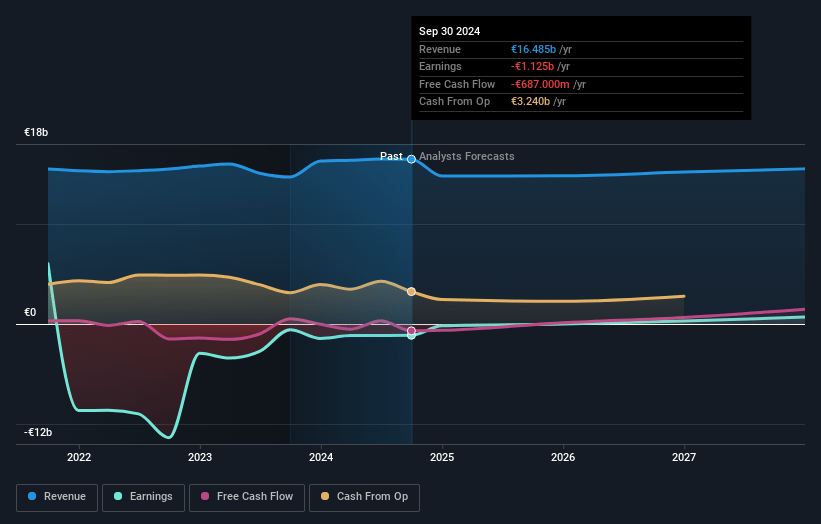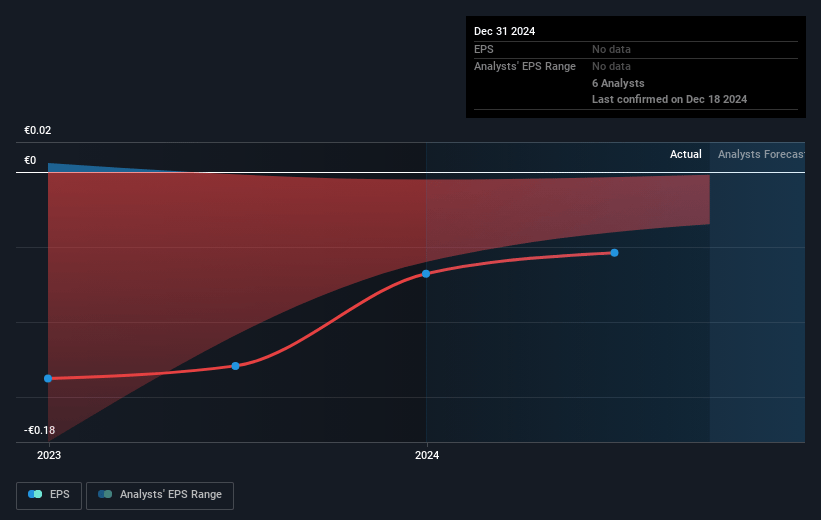Key Takeaways
- Deconsolidation of non-core assets and operational improvements enhance financial flexibility, enabling reinvestment in growth areas and improved margins.
- Strategic investments in digital services, cloud solutions, and infrastructure support long-term revenue and earnings growth.
- Challenging domestic market and foreign exchange risks pressure Telecom Italia's growth, with reliance on regulatory changes and new initiatives potentially affecting future revenues.
Catalysts
About Telecom Italia- Engages in the provision of fixed and mobile telecommunications services in Italy and internationally.
- The deconsolidation and disposal of non-core assets, including Sparkle and INWIT, have enhanced financial flexibility, allowing TIM to reinvest in areas expected to drive future growth. This is likely to improve net margins and cash flows.
- Significant improvements in operational efficiency and financial health, such as achieving a reduction in net debt and enhancing the leverage ratio to below 2x, restore strategic flexibility and capacity to invest or capitalize on future growth opportunities, affecting earnings positively.
- The focus on positioning TIM Enterprise and TIM Consumer as leaders in the Telco and ICT market, coupled with investments in digital services and cloud solutions, is expected to drive revenue growth.
- Expansion initiatives, such as increasing 5G infrastructure in Brazil and constructing new data centers in Italy, are anticipated to support long-term revenue and EBITDA growth by enhancing service offerings.
- The successful signing of significant enterprise and public sector contracts, especially through the National Strategic Hub, emphasizes long-term projected revenue growth, thus supporting sustainable earnings improvement.
Telecom Italia Future Earnings and Revenue Growth
Assumptions
How have these above catalysts been quantified?- Analysts are assuming Telecom Italia's revenue will decrease by 0.9% annually over the next 3 years.
- Analysts assume that profit margins will increase from -1.1% today to 2.6% in 3 years time.
- Analysts expect earnings to reach €392.8 million (and earnings per share of €0.02) by about April 2028, up from €-163.0 million today. However, there is a considerable amount of disagreement amongst the analysts with the most bullish expecting €432.6 million in earnings, and the most bearish expecting €353 million.
- In order for the above numbers to justify the analysts price target, the company would need to trade at a PE ratio of 25.0x on those 2028 earnings, up from -41.9x today. This future PE is greater than the current PE for the US Telecom industry at 19.3x.
- Analysts expect the number of shares outstanding to remain consistent over the next 3 years.
- To value all of this in today's terms, we will use a discount rate of 9.5%, as per the Simply Wall St company report.
Telecom Italia Future Earnings Per Share Growth
Risks
What could happen that would invalidate this narrative?- The domestic market in Italy remains extremely competitive and challenging, which can pressure the company's ability to grow revenues and maintain margins.
- TIM is reliant on regulatory changes and market consolidation in Italy to improve business conditions, which is uncertain and can impact future earnings.
- TIM's strategy relies on successfully executing new business initiatives, such as expanding into energy services and ICT, which carry risks of underperformance that could affect future revenues.
- The company is exposed to foreign exchange rate fluctuations affecting its Brazilian operations, potentially impacting earnings and financial forecasts.
- The potential for missed guidance due to external factors, such as geopolitical issues affecting contracts like Sparkle, poses a risk to revenue and EBITDA forecast stability.
Valuation
How have all the factors above been brought together to estimate a fair value?- The analysts have a consensus price target of €0.351 for Telecom Italia based on their expectations of its future earnings growth, profit margins and other risk factors. However, there is a degree of disagreement amongst analysts, with the most bullish reporting a price target of €0.44, and the most bearish reporting a price target of just €0.25.
- In order for you to agree with the analyst's consensus, you'd need to believe that by 2028, revenues will be €14.9 billion, earnings will come to €392.8 million, and it would be trading on a PE ratio of 25.0x, assuming you use a discount rate of 9.5%.
- Given the current share price of €0.32, the analyst price target of €0.35 is 8.5% higher. The relatively low difference between the current share price and the analyst consensus price target indicates that they believe on average, the company is fairly priced.
- We always encourage you to reach your own conclusions though. So sense check these analyst numbers against your own assumptions and expectations based on your understanding of the business and what you believe is probable.
How well do narratives help inform your perspective?
Disclaimer
Warren A.I. is a tool utilizing a Large Language Model (LLM) that ingests data on consensus price targets, forecasted revenue and earnings figures, as well as the transcripts of earnings calls to produce qualitative analysis. The narratives produced by Warren A.I. are general in nature and are based solely on analyst data and publicly-available material published by the respective companies. These scenarios are not indicative of the company's future performance and are exploratory in nature. Simply Wall St has no position in the company(s) mentioned. Simply Wall St may provide the securities issuer or related entities with website advertising services for a fee, on an arm's length basis. These relationships have no impact on the way we conduct our business, the content we host, or how our content is served to users. The price targets and estimates used are consensus data, and do not constitute a recommendation to buy or sell any stock, and they do not take account of your objectives, or your financial situation. Note that Warren A.I.'s analysis may not factor in the latest price-sensitive company announcements or qualitative material.




